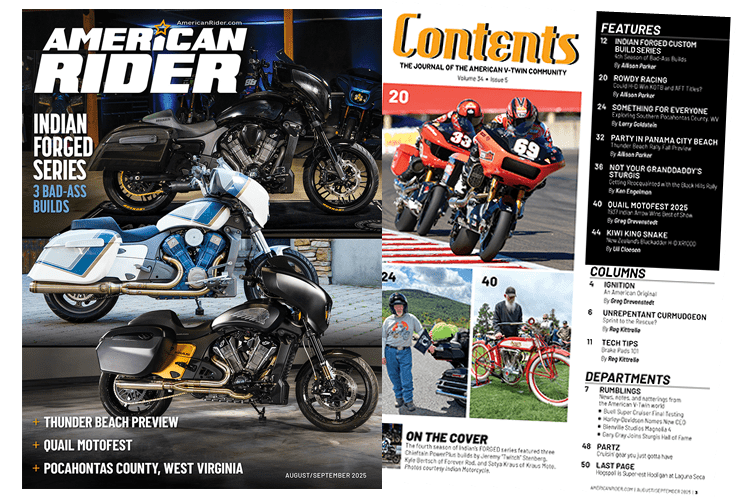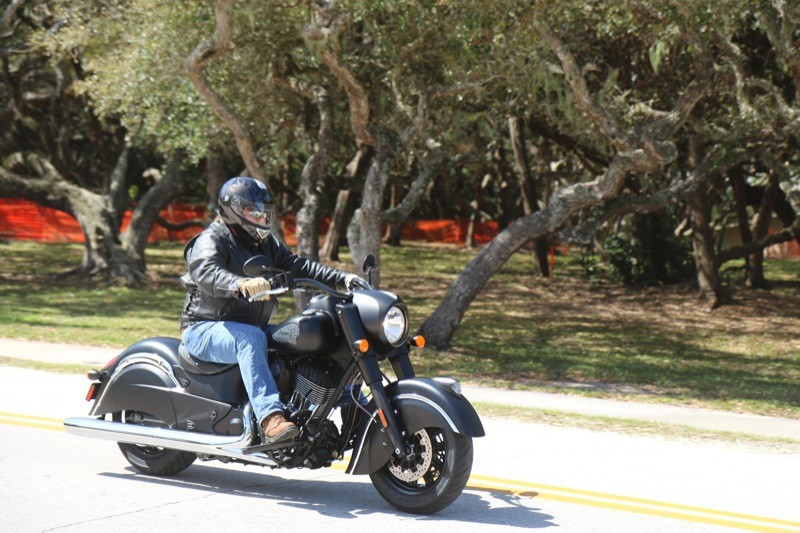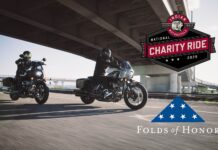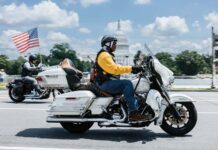Over the last century, the Indian Motorcycle Company has seen more incarnations than a Tibetan holy man. The latest iteration emerged two years ago with the release of the revolutionary Thunder Stroke 111 en

gine during Daytona Bike Week—just the engine, not a complete bike. But that proprietary motor alone caused quite a stir with the Florida crowd with rally goers lining up at Destination Daytona just to hear the thing run. What followed was a well-crafted campaign of advertising, tantalizing consumers with hearsay and innuendos. And just when we thought we knew in which direction the product line would be headed, Indian managed to surprise us once again. And the recently released Chief Dark Horse follows a similar path.

To call it Dark is almost an understatement with this satin stallion taking the blacked-out effect to the extreme. Other than the exhaust, pushrod tubes, clutch cover, some strips accenting the perimeter of the heavily-valanced fenders and a handful of fasteners, the Dark Horse is almost devoid of chrome. Even the iconic War Bonnet affixed atop the front fender has received a dose of dark. The finish is not a true flat black but closer to a semi-gloss, presenting a striking departure from the remainder of the Indian model lineup. The badging on the 5.5-gallon fuel tank completes the effect with distinctive monochrome graphics that can only be found on the Chief Dark Horse. This unpolished matte appearance is dramatic and one of the most appealing aspects of the Dark Horse, the others being power and handling.

to the Chief Dark Horse
The Thunder Stroke 111 (1811cc) has proven itself over the last few years to be a hearty beast, grunting its way through six gears with a robust dose of low-end torque. It is a 49-degree unit- construction V-twin with side-by-side connecting rods and bottom-yoke bearing caps. The placement of the cam package allows for a centralized mass, a crankshaft that is 2” lower than anything comparable and an overall reduction in motor height resulting in an excellent center of gravity. The engine is solid mounted with a torque converter coming off the left side and uses a right-side belt to get power to the rear wheel. A common oil reservoir supplies lubrication to the motor, transmission and primary drive; not the standard system in the V-twin world but one the company stands behind after extensive testing. Pumping out 119 ft/lbs of torque, the bike weighs in at 751 lbs. dry, making it the lightest of all the Chief models and further enhancing the throttle response and overall quickness. The exhaust is handled by a split system joined by a crossover connection and delivers a throaty exhaust note.

The road-proven rear monoshock is teamed with a heavy-duty cast swingarm delivering 3.7” of travel. The front forks are 46mm and allow for 4.7” of compression. An aluminum nacelle with a very unique shark fin bridge along its nose blends well with the fork covers and lower legs—all treated to that low-gloss finish. The absence of any auxiliary lights only adds to the bike’s sleek appearance. And those pullback handlebars literally meld into the headlight housing. Lighting is via a halogen unit.
Dual 300 mm rotors with 4-piston calipers handle the braking chores up front while a single 300mm with 2-piston caliper is supplied on the rear, together providing ample whoa-up capabilities. Both rotors are full floating and ABS comes standard. The bike rides on Dunlop American Elites tires, a 180/65-16 in the back and a 130/90-16 leading the way, a combination that is excellent. This mix of suspension, rake and braking along with near perfectly-placed handlebars and the light weight affords a rider great control and a bike that gobbles up the road. A seat upgrade might be the only item in need of addressing as the stock unit seems too soft.

strips can be replaced with black trim
A remote key fob means a keyless ignition but a personalized security code has been added in case of a misplaced fob (nice touch). A somewhat large start/stop pushbutton just above the speedometer is part of the dash. In keeping with traditional styling, the gas tank has two caps with the one on the left being a dummy cap, only for appearance. The fenders are constructed of heavy-gauge steel while the side panels below the seat are ABS plastic, hiding all the electronics.

rear fender
Although the Dark Horse comes equipped for a solo rider, an optional passenger seat and pegs are available—in my opinion, a choice that would totally destroy the image of this fine machine. Instead of popping a pillion on the rear fender, I would recommend the purchase of the Pinnacle One-Up Luggage Rack, in black, of course. Other accessories include 16” apehanger handlebars, Stage 1 slip-on exhaust, fishtail exhaust tips and blacked-out fender trim to eliminate what little flash the bike carries stock.

The Dark Horse is unique to this new breed of Indian Motorcycle. While retaining many of the traits of the other models, its finish and minimalist profile distinguish it from the herd, excelling in its simplicity. Utilizing a proven chassis and reputable powerplant, the packaging of the product is icing on what is already a highly-respected machine. The bright side to all this blackness? The Indian Chief Dark Horse carries a starting price of $16,999.


under the seat and behind these panels

just push the big black starter button on the dash and go

















